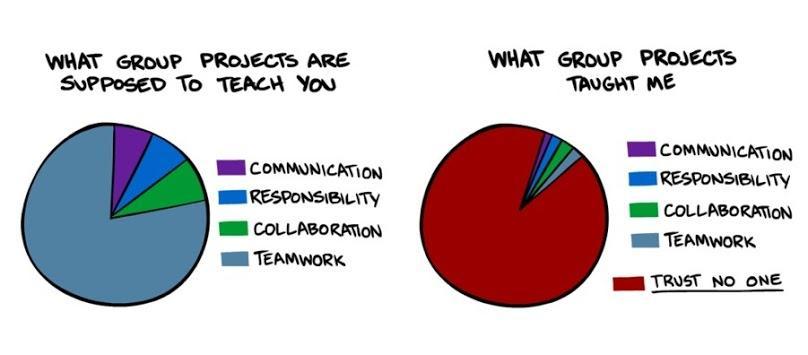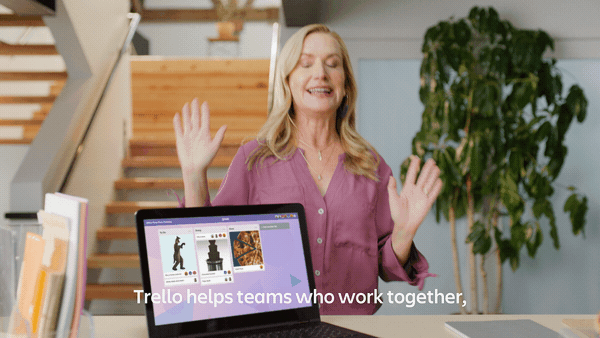Ah, teamwork. When everyone’s in sync and productivity is high, working together is a dream. You meet your deadlines with ease, your brainstorms produce the best ideas, and working together is – dare I say it? – fun.
On the other hand, a team that’s having problems working together can make everything at work, from meetings that never end, to the pressure of unrealistic goals and expectations, seem as cold and un-motivating as this morning’s dregs in your office coffee pot.
Everyone wants to be more productive, and a key part of getting more of your to-dos done at work is working better with your team. Research from Gallup’s State of the American Workplace report found that engaged teams deliver positive results. In fact, these teams see improvements over their less-motivated counterparts in all kinds of areas:
- 17% higher productivity overall
- 10% higher customer satisfaction
- 20% higher sales
- 21% higher profitability
- And a whopping 41% reduction in absenteeism
Group work is always going to have its inherent difficulties, but if your team (a) actually wants to come to the office (even a virtual one), and (b) has a clear purpose on why collaborating is worth the trouble, it makes those bumps easier to manage.
Hearkening back to the old adage that all 💩 rolls downhill, if your team isn’t engaged, their output negatively affects their teammates, which influences the entire work environment, and ultimately, the bottom line. A global study by Gallup on employee engagement and motivation found that 85% of employees worldwide are “not engaged or actively disengaged at work”, resulting in a global downwards trend of workplace productivity. In other words, we have some work to do.
Harnessing engagement and motivation is important to the DNA of all teams. It helps ground the team in purpose. Improving motivation starts with making changes to how the team works, to create an environment where collaboration and performance are shared, visible, and easily managed.
How does your team work together?
At Trello, we think a lot about this. In particular, how teams can work better, together. We’ve identified three critical pillars that need to be put in place in order for your team’s productivity to thrive:
- An actively evolving team culture that values trust over talent.
- The co-owned prioritization of work, so that everyone has a say – and a stake – in what they work on.
- A structured approach to the ‘how’ of teamwork that solves basic team needs so everyone can feel free to clear away confusion and get the job done.
We’ve even created a toolkit to help you build these core ways of working into your team’s everyday collaboration. Meetings don’t have to waste time, projects can be delivered promptly, and your team can enjoy working together. Instead, you’ll have time for more important things:

So let’s dive in and break down exactly how to build up productivity in your team’s workday in a way that’s worth celebrating.
Always be actively creating team culture
The value of trust in the workplace gets a bad rap thanks to cheesy motivational posters and awkward team-building games, but there are some really good reasons for why you should put culture first and implement some cornerstones of culture building into your team routine.
An emotionally-intelligent team is more productive because personal investment on the part of each member builds engagement and innovation. And yet, according to a global study of trust in the workplace by EY, just 49% of professionals worldwide have a “great deal of trust” in their teams and colleagues.

What constitutes the unique traits of your team culture are only limited by your imagination, but there are some set conditions for creating a trustworthy team culture that grows productive collaboration. According to EQ experts Dr. Vanessa Druskat and Dr. Steven Wolff in their detailed analysis for Harvard Business Review: “Our research tells us that three conditions are essential to a group’s effectiveness: trust among members, a sense of group identity, and a sense of group efficacy.”
The Trello team actually look at psychological safety as a core component of trust. Psychological safety is defined by how each of your team members perceive threat vs. safety when considering taking a risk at work.
According to Harvard Business Review, teams with true psychological safety take more healthy risks, are more comfortable speaking their mind, being creative, and feeling comfortable to question and challenge ideas — the types of behaviors that lead to success. Team members feel confident that they won’t be made to feel embarrassed or punished unfairly for making a mistake, asking a question, or offering up a new idea.
Merely paying lip service to trust, however, won’t make it a real pillar of team productivity. To keep things open, for example, the Trello Marketing team has a standing “Wednesday Woes” item in their weekly team meeting where everyone brings up mistakes, learnings, problems, and concerns to discuss. Another strategy is to have a communications plan (ours is called “When to Slack and When to Hold Back”) that’s co-written by the team and reviewed on a bi-annual basis. This details appropriate ways to communicate in chat, on email, and in meetings. Whatever you choose, it should be a group decision to define and a group responsibility to maintain what informs your team’s culture.

Prioritize your team’s right to choose
The co-owned prioritization of what your team works on has a profound effect on team productivity and retention. A joint research study between The Energy Project and Harvard Business Review analyzed various facets of work satisfaction, and prioritization was a strong motivating factor: those who were able to effectively prioritize their work reported being 48% more engaged and 89% more likely to stay with their current employer.
The people on your team don’t want to feel like bystanders to how their work gets prioritized, but that doesn’t mean it’s as easy as letting teams freewheel and sort it out on their own. In the same study, just 16% of respondents said they regularly made time for creative and strategic thinking, the lowest result for any behavior in the survey. And even though people who make time for strategy are 83% more likely to stay with their organization, only one third of respondents felt they could effectively prioritize their work.
The findings also show that having team leadership assign work isn’t the best approach either: less than 25% said their boss set clear priorities and kept the team focused. So what’s the best approach? Transparency is a great place to start, by keeping information open and accessible to anyone, with the goal of breaking down silos between teams.
The style of how to prioritize work should be decided by your team. How would they prefer to define their to-do lists? An interactive approach that’s flexible, such as Scrum in Trello, might be an option. Does your team define success and set goals collaboratively? (Truly?) If your team could work on anything they wanted, what would it be? These are all-important questions to not just ask yourself, but to ask each other.
Build in structure that can stretch
As much as everyone likes to write their own rules, a lack of team structure makes maintaining cohesive and effective team productivity tough. For one, without structure, it’s harder to depend on each other, and dependability has been found by Google researchers to be the second-most important factor in building effective teams (after psychological safety).
According to Gallup’s State of the American Workplace, each of your team members has needs to be met in order to be successful at work. These break down into basic, individual, teamwork and growth needs. Basic and individual needs are paramount to getting a team to a base level of productivity:
- They need to know what’s expected of them. (Basic need)
- They need the right materials and equipment. (Basic need)
- They need to be able to do what they do best. (Individual need)
- They need recognition that they accomplish work successfully. (Individual need)
Without these assurances, even the most closely-bonded team won’t be able to stay on course. At Trello, we build common structural approaches into all of our workflows that create a united sense of how work is done. For example, each Trello board has a “Start here!” list on the left side, where important information, resource materials, and other key details are kept. Anyone beginning work on any board knows where to look to get oriented. We also keep visible “Done” lists on every board, with each completed item assigned to the person who achieves it. This keeps finished work visible and ready for recognition.
We also aren’t afraid to make changes when the current workflow structure stops being effective for the team. For example, if there are too many tasks stacking up for approvals on a project in the “Doing” list, we create a new list labeled “Needs Approval”. Once the approvals clear up, that list might be archived until it’s needed again.
Your team will be more productive with some standardization to how work gets done, so long as it’s tailored to meet their needs. You’ll also save time if you can quickly adjust those processes in order to stay flexible and keep the good teamwork flowing.

Team productivity, meet the Trello Team Toolkit
We believe in these pillars of teamwork so much that we’ve developed the new Trello Team Toolkit, a free collection of five workflows for any type of teamwork: from time-wasting meetings to projects without a plan, from big goals to team resources that desperately need a little organization.
The spirit of solid teamwork is built into every Trello board in the collection. Each is geared to be a transparent, horizontal way for your team to collaborate clearly and work better, together – while having a little fun along the way. Your team can copy the workflows into Trello for free, then customize them to make them as productive as possible.
We even teamed up with office party planner extraordinaire, Angela Kinsey, to get the productivity party started. Now that you’ve built the foundation for great teamwork, it’s time to celebrate. Come on over to get your copy of the Toolkit and see how the party turns out.







































